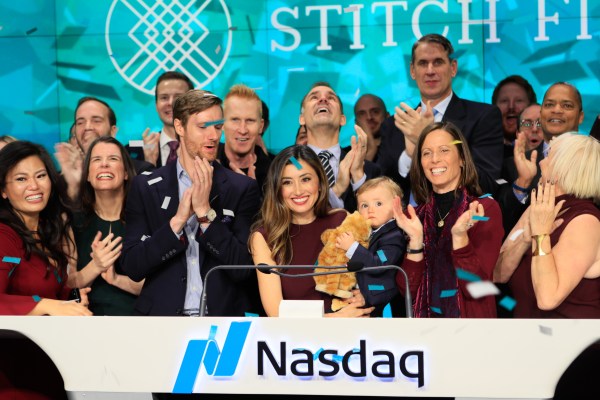It’s been just ten days since Stitch Fix debuted on the stock market, and it has risen almost 54 percent since that time. It’s an astonishing feat for the fashion styling business, which got off to a rough start, but quickly turned things around as it started to gain momentum by its third day of trading and soared 24 percent today, better known as “Cyber Monday.”
For those who didn’t watch this highly anticipated IPO, Stitch Fix originally priced its offering at $15, which was below its proposed price range of $18 to $20, even after reducing the size of its offering. It then closed the first day at $15.15, below the opening price of $16.90. The following day it “broke issue,” closing beneath the $15 IPO price. And all of this was well beneath the $22.61 that the company valued its buyback at last year.
Last Tuesday, however, Stitch Fix changed course, and it’s been on a roll ever since. One possibility for the bullish sentiment could be that investors are predicting a big holiday quarter for e-commerce and this business in particular. Amazon shares have also gone up this week.
Gene Munster, formerly an analyst at Piper Jaffray and now a venture capitalist at Loup Ventures, says it’s “probably a couple of large buyers, and the chart starts working, and people feel like they’re missing something.”
He believes that it mostly boils down to simple supply and demand. Stitch Fix did what’s called a “low float,” meaning it made a relatively low number of shares available for sale — which is often the case with newly public companies.
Still, while there’s often volatility in the days following an IPO, statistics show that what happened with Stitch Fix is highly unusual. Munster says that he “can’t remember when it’s happened like this.”
According to Dealogic, U.S.-listed companies that trade flat on the first day, or within 1 percent above or below the IPO price, are up an average of just 1.6 percent one month following their IPO. This compares to 16 percent gains for other newly listed companies in the same timeframe.
The correlation continues longer term, with flat first-day companies trading up 10.8 percent one-year out from the debut. Other U.S.-listed companies average 20 percent gains between the time of their IPO and the following 12-month period.
That’s why there’s so much scrutiny on the first day “pop,” the term used to describe the gains that are expected to happen on day one. Investment bankers advise companies to price IPOs about 15 to 30 percent beneath their predicted first day performance, sometimes characterized as a “discount” to encourage new investors to buy the stock. It’s also meant to prevent the stock from falling in the following weeks or months.
Because of the perceived importance of the “pop,” bankers often exercise what’s called a “greenshoe option,” where they can buy back shares at the IPO price to save face in the first 30 days. It appears that they did this with Stitch Fix on the first day. In this case, bankers were allowed to buy up to 1.2 million shares.
While it’s certainly too soon to declare Stitch Fix a long-term success, its short-term performance defies the odds. In fact, Kathleen Smith, manager of Renaissance Capital, the IPO ETF, calls this turnaround “rare.” She says that, typically, “breaking your IPO price leaves an imprint.”
The bull case for Stitch Fix is that it has built a fast-growing fashion business and did this with little capital. The company raised just a reported $42 million from Benchmark Capital, Lightspeed Venture Partners and Baseline Ventures.
In just six years, co-founder and CEO Katrina Lake has built a company with $977.1 million in annual revenue. She’s also the youngest woman to ever take a company public, according to the Nasdaq.
Stitch Fix has already achieved profitability in some years, although it turned to a small loss of $594,000 for 2017. Last year Stitch Fix saw $33.2 million in net income.
Stitch Fix has become a leader in a growing category of try-it-before-you-buy-it fashion businesses. The company’s mix of algorithms and human stylists help determine which outfits should be sent to regular customers.
Of course, there’s always a bearish case for a stock, too. In this case, some IPO investors were burned on Blue Apron’s rough stock market run and may at first have been wary of anything that looked like subscription commerce. (The people who have access to the IPO price are a different group than typical retail stock market investors. It’s an exclusive group of institutional investors and hedge funders, who are expected to hold their positions to keep the stock stable).
We’re also told that some investors were initially concerned that co-founder and CEO Katrina Lake had planned to sell shares at the time of the IPO, a practice that is sometimes construed as a signal that insiders are less than confident about a company’s longer-term performance.
Lake nixed those plans after reducing the size of the IPO, saying she believed the company should be valued at more than $15.
Other concerns included the company’s short “lock-up” period, with 35 percent of insider shares potentially eligible for sale after just 90 days, dependent on stock performance. Companies typically have employees wait until the 180-day mark because the selling can cause the stock to dip. Additionally, CFO Paul Yee has only been with the company for five months, and the company’s COO, Mike Smith, was just promoted in October. We’ve heard that this spooked some of the IPO buyers.
There were also some fears about decelerating growth and high customer acquisition costs.
Either way, it looks like Stitch Fix’s early gains are a “Christmas present,” says Smith, who calls it “encouraging to see the stock make these recoveries.”
We talked about the Stitch Fix pricing and more on the latest episode of TechCrunch’s “Equity” podcast.
